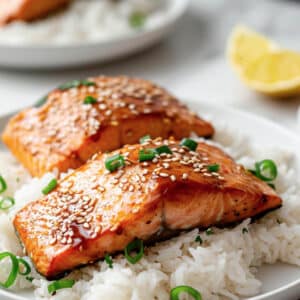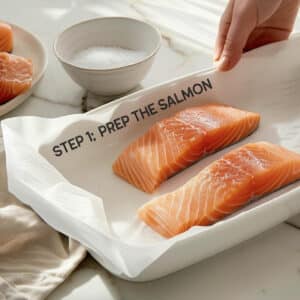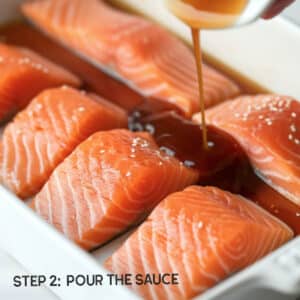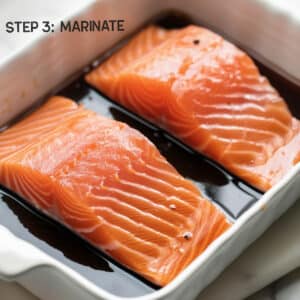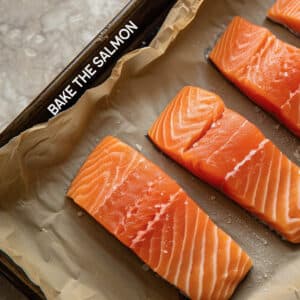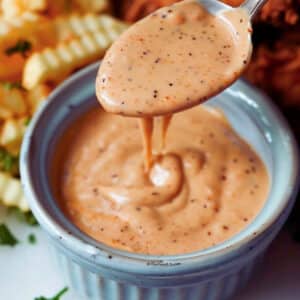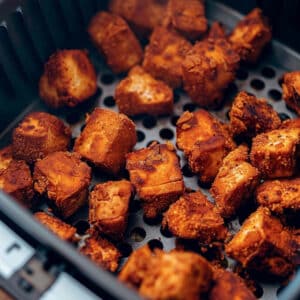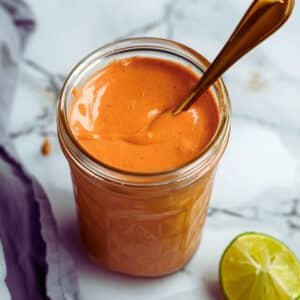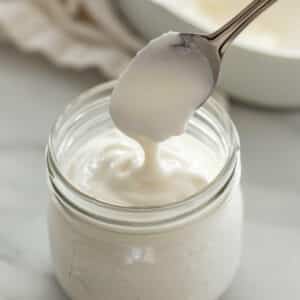Fancy a meal that's both yummy and easy? Teriyaki salmon is your go-to. Perfect for those nights when you're short on time but still want something tasty. The homemade teriyaki sauce really makes the salmon pop with flavor. It's a quick, scrumptious choice for dinner with an Asian twist.
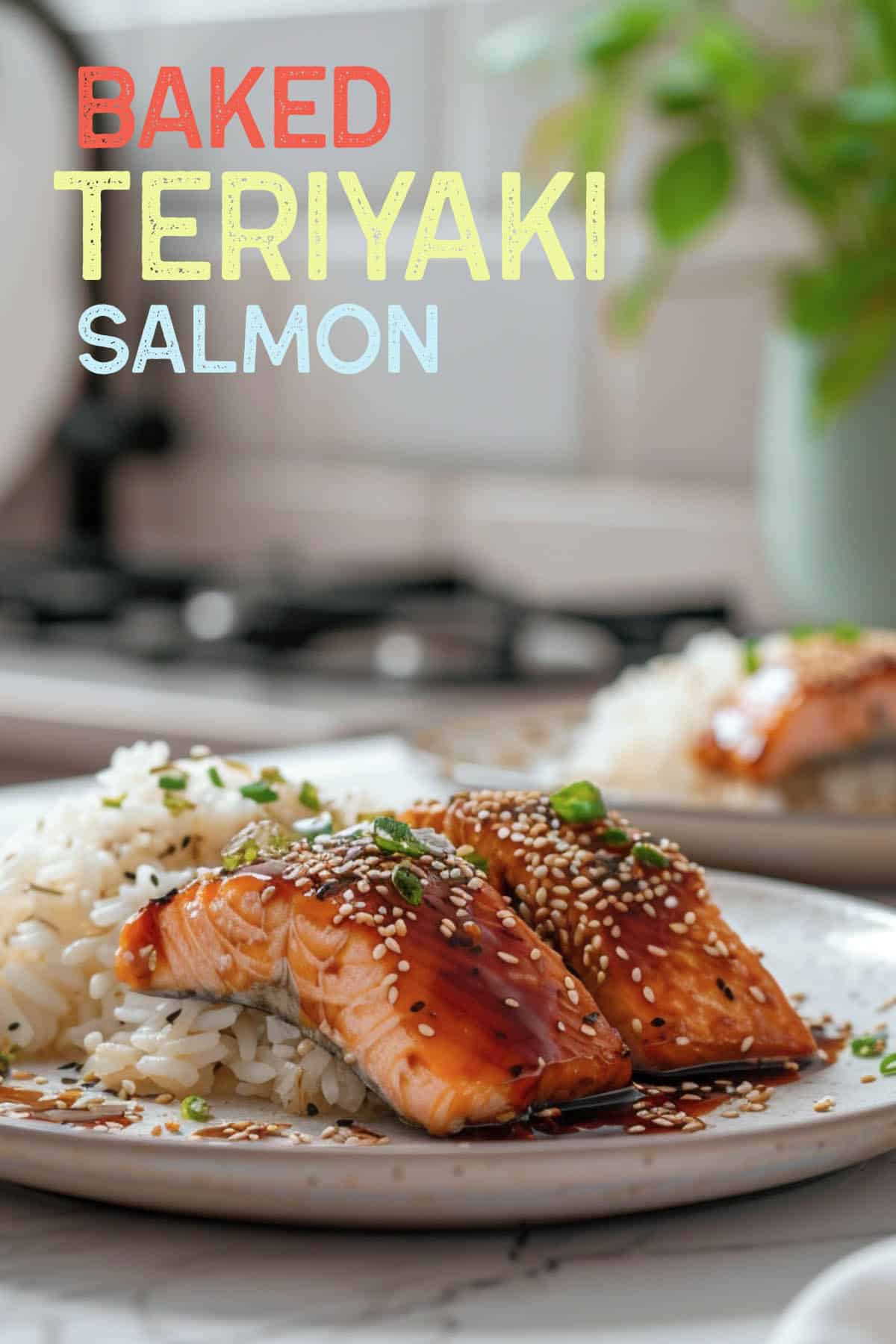
Take aways:
- Homemade is Best: Making your own teriyaki sauce can elevate the flavors of your salmon dish.
- Prep Like a Pro: Follow the easy preparation steps to ensure your teriyaki salmon turns out perfectly every time.
- Bake to Perfection: Utilize the baking instructions provided for a simple and delicious way to cook teriyaki salmon.
- Handle with Care: Learn the proper techniques for cutting salmon into Japanese-style fillets to enhance the presentation and texture of your dish.
Jump to:
Ingredients for Making Teriyaki Salmon
Prepare the Sauce (Or Opt for Pre-made)
Let's talk about that teriyaki sauce, shall we? You might be thinking, "Why not just grab a bottle off the shelf?" And you're not wrong. It's quick, it's easy, and hey, if you're shooting for a meal that's got like two ingredients, it's perfect for keeping things simple. Another option is using the Soyaki sauce. I posted the recipe here so you can check it out.
But here's a little twist: whipping up your own sauce is actually super easy – and quick too! We're talking less than 10 minutes, and even less time if you've got garlic and ginger already minced. Just a heads-up from someone who's been there.
Homemade Teriyaki Sauce
Making it is a no-brainer. Just take soy sauce, ginger, garlic, brown sugar (or honey), a bit of sesame oil, and a splash of Mirin or rice vinegar, throw them all into a saucepan, and heat it up till it starts to simmer. Simmer the mixture until it thickens to a glaze-like consistency, and there you have it: homemade teriyaki sauce! Need more guidance? Check out the recipe post I mentioned; it's got all you need.
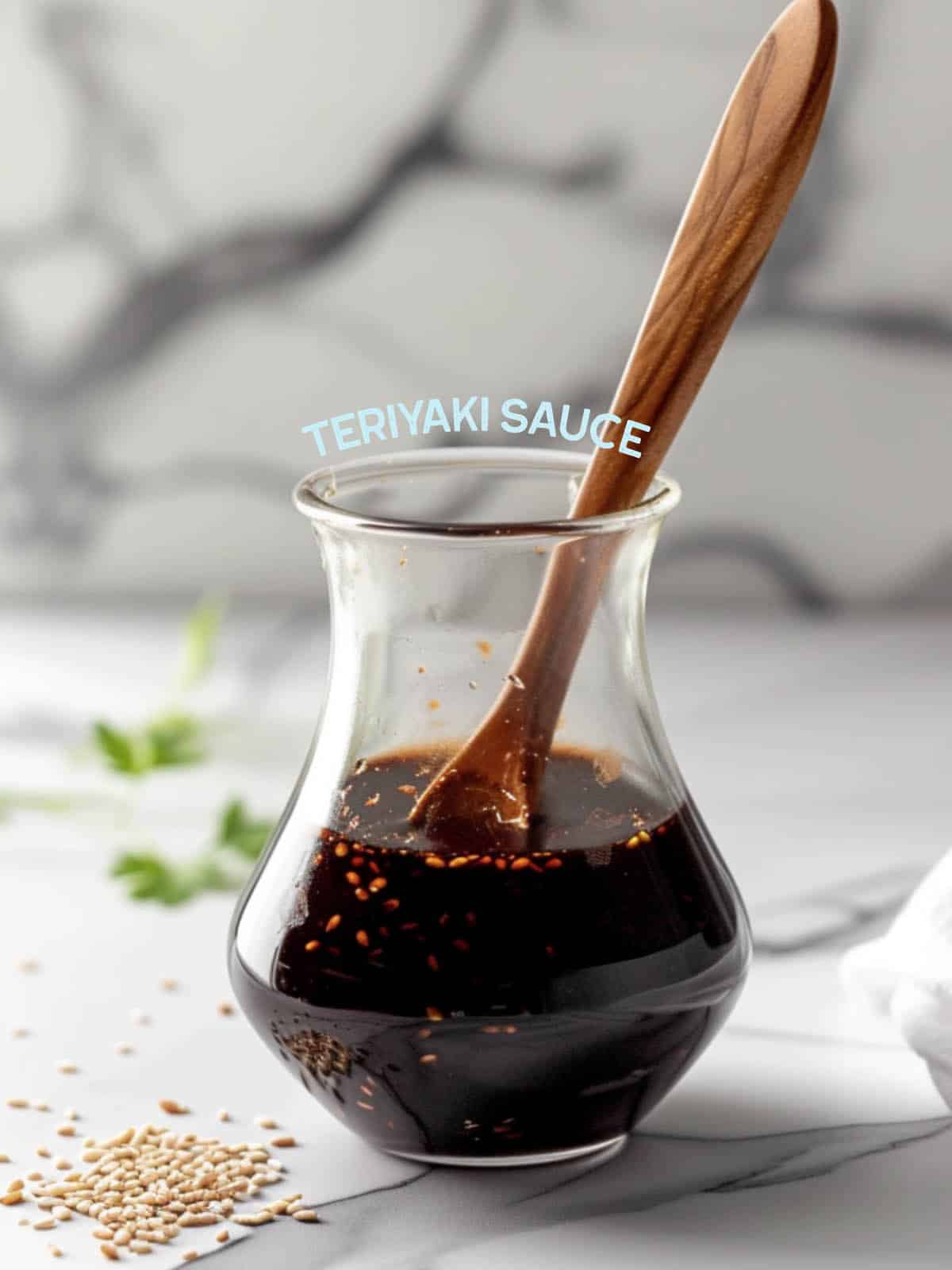
Extra Tips:
Here's the thing about making your own teriyaki sauce: it's all about tailoring it to your taste. If you're someone who loves a bit more sweetness, go ahead and add some honey. It's like putting your personal stamp on the sauce.
And about the salmon – a little tip is to brush it lightly with oil before you grill or bake it. This simple step is key to locking in all that moisture, making sure the salmon comes out juicy and flavorful. It's like giving the salmon a little armor, so it keeps all the good stuff while it cooks.
Teriyaki Salmon Preparation Steps
Prepping the Salmon. To start making teriyaki salmon, begin by patting dry the salmon fillets with paper towels. This step helps remove excess moisture from the fish, ensuring a better texture when cooked. Once dried, place the salmon in a shallow dish or resealable plastic bag, ready to absorb all the flavors of the teriyaki sauce.
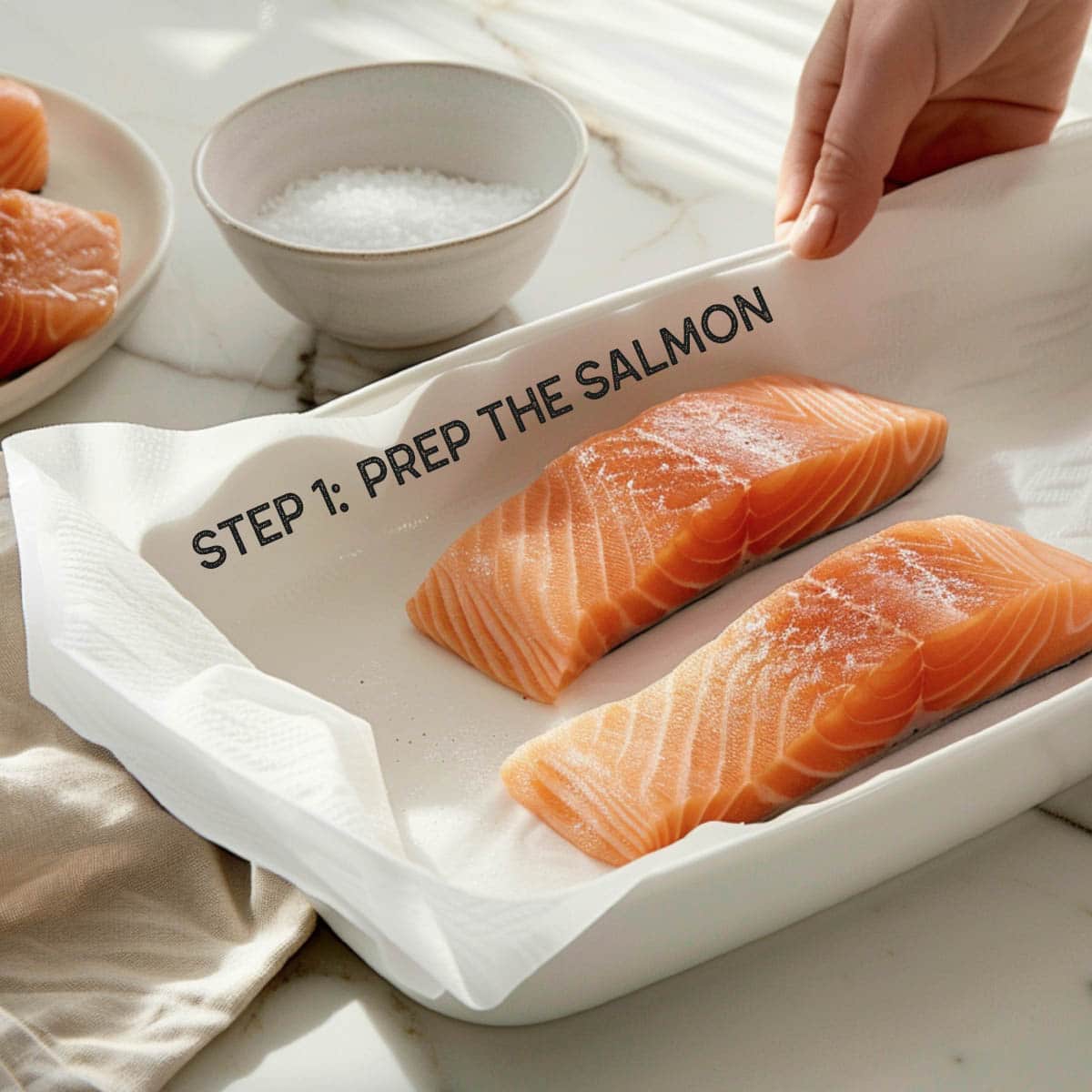
Marinating. Next, pour teriyaki sauce over the salmon fillets in the dish. The rich and savory teriyaki sauce will add depth and sweetness to your salmon dish. Ensure that each piece is generously coated with the sauce for maximum flavor infusion.
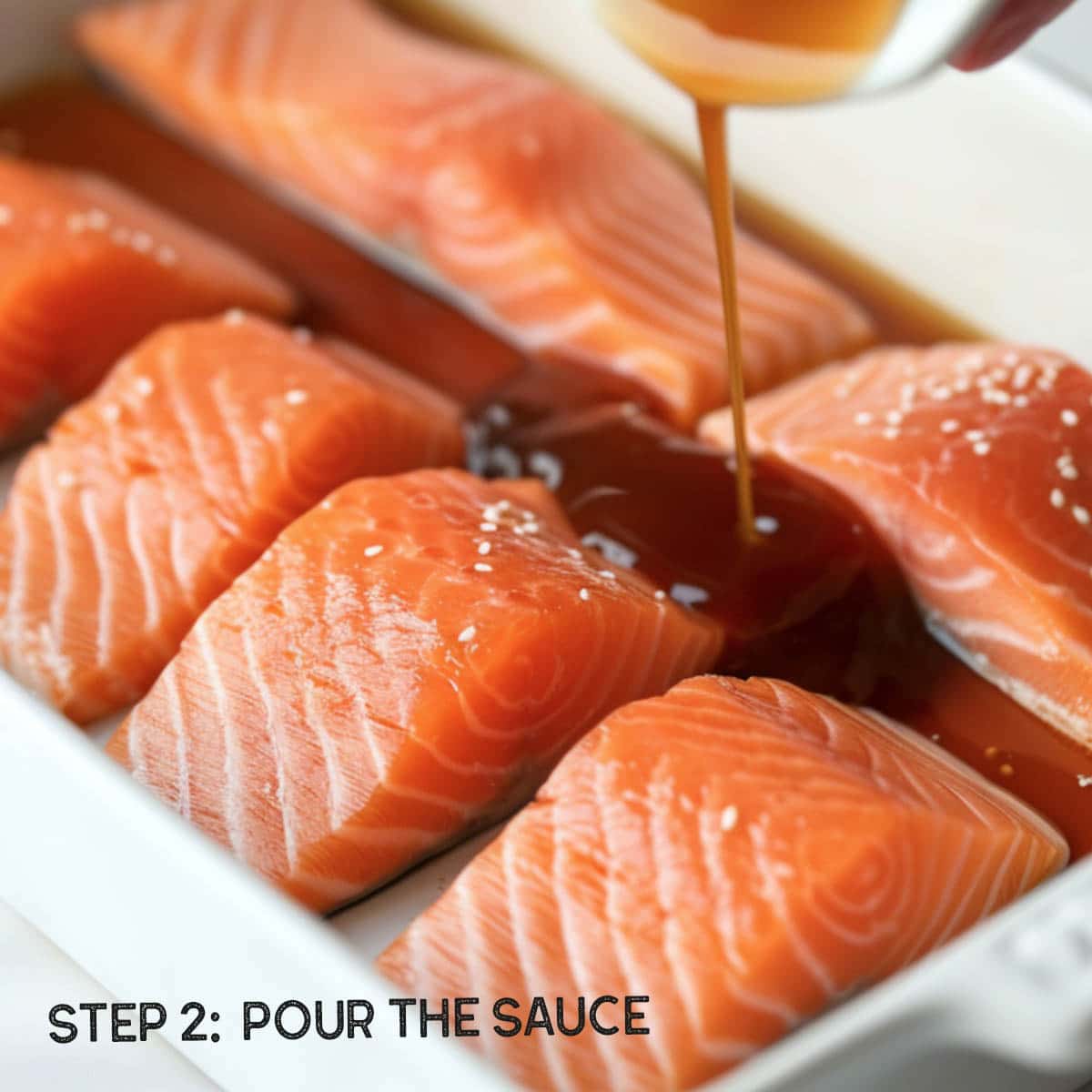
Marinating Time. After pouring the teriyaki sauce, allow your salmon to marinate for at least 30 minutes in the refrigerator. Marinating is crucial as it allows time for the flavors of soy sauce, Mirin, and sugar in teriyaki sauce to penetrate and enhance every bite of your fish.
During this time, cover your dish with plastic wrap or aluminum foil to prevent other odors from seeping into your marinade. The longer you let it sit (up to overnight),the more intense and flavorful your teriyaki salmon will be when cooked.
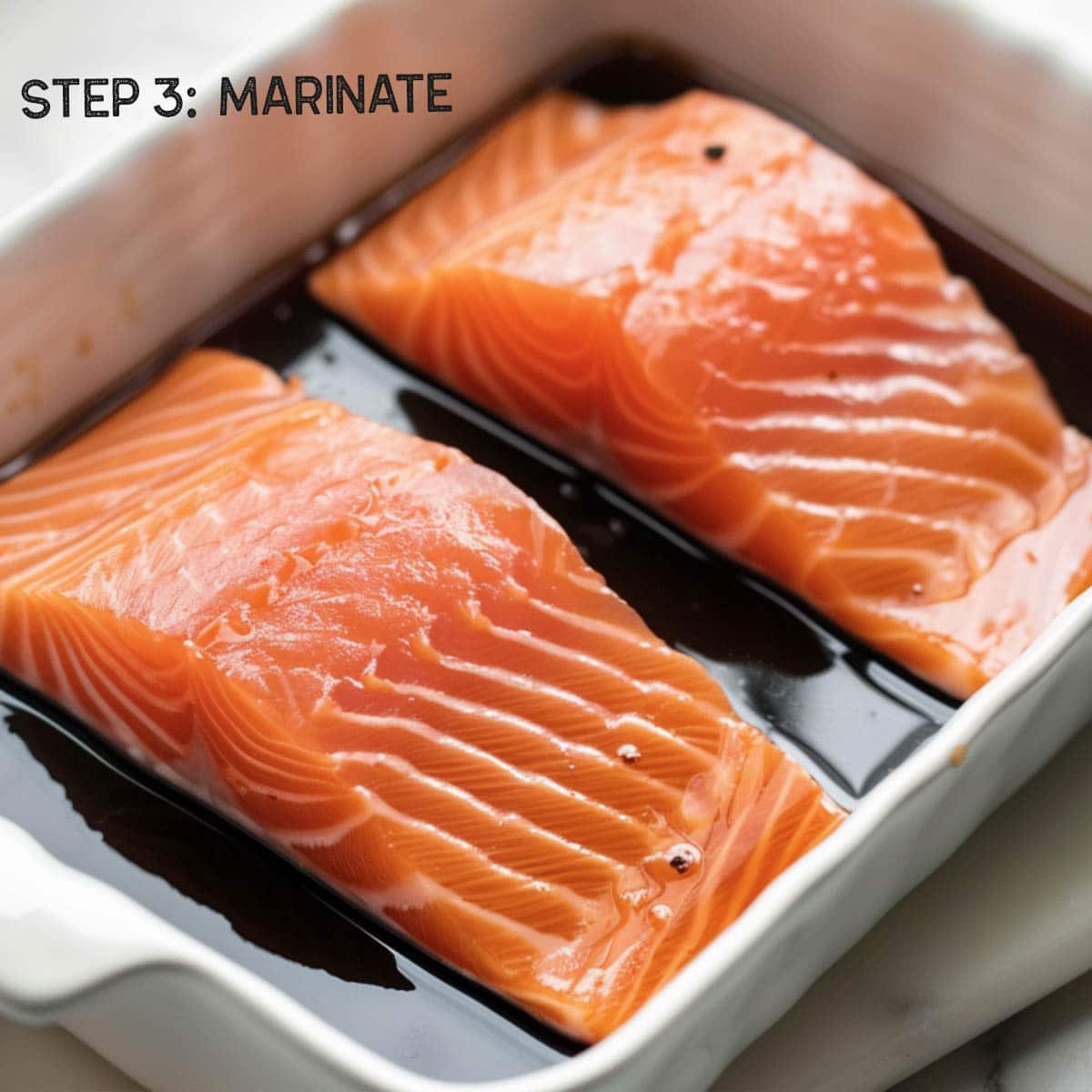
Baking Instructions for Teriyaki Salmon
Preheating the Oven. First things first, crank your oven up to 400°F (200°C). This step ensures that the oven reaches the right temperature for cooking.
Why preheat? Well, it's like giving your oven a heads-up, "Hey, we're cooking something great here!" It ensures your salmon cooks evenly, no undercooking or overcooking mishaps. It's all about setting the stage for your salmon to shine.
Setting Up the Baking Sheet. Now, let's get your baking sheet ready. You lay down parchment paper or foil first – keeps everything clean and makes tidying up a breeze later on.
Bake the Salmon. Okay, let's break down the cooking time for salmon, because it's not a one-size-fits-all kind of deal. The thickness of your salmon? It matters. And the type – like, if it's a fattier piece, you've got a bit more leeway before it goes from juicy to dry.
Here's what I suggest: Give it a check around the 10-12 minute mark. You're aiming for a light pink color throughout. No dark pink or red bits that scream 'I'm not cooked yet!' The perfect piece should flake off easily and be tender, not tough.
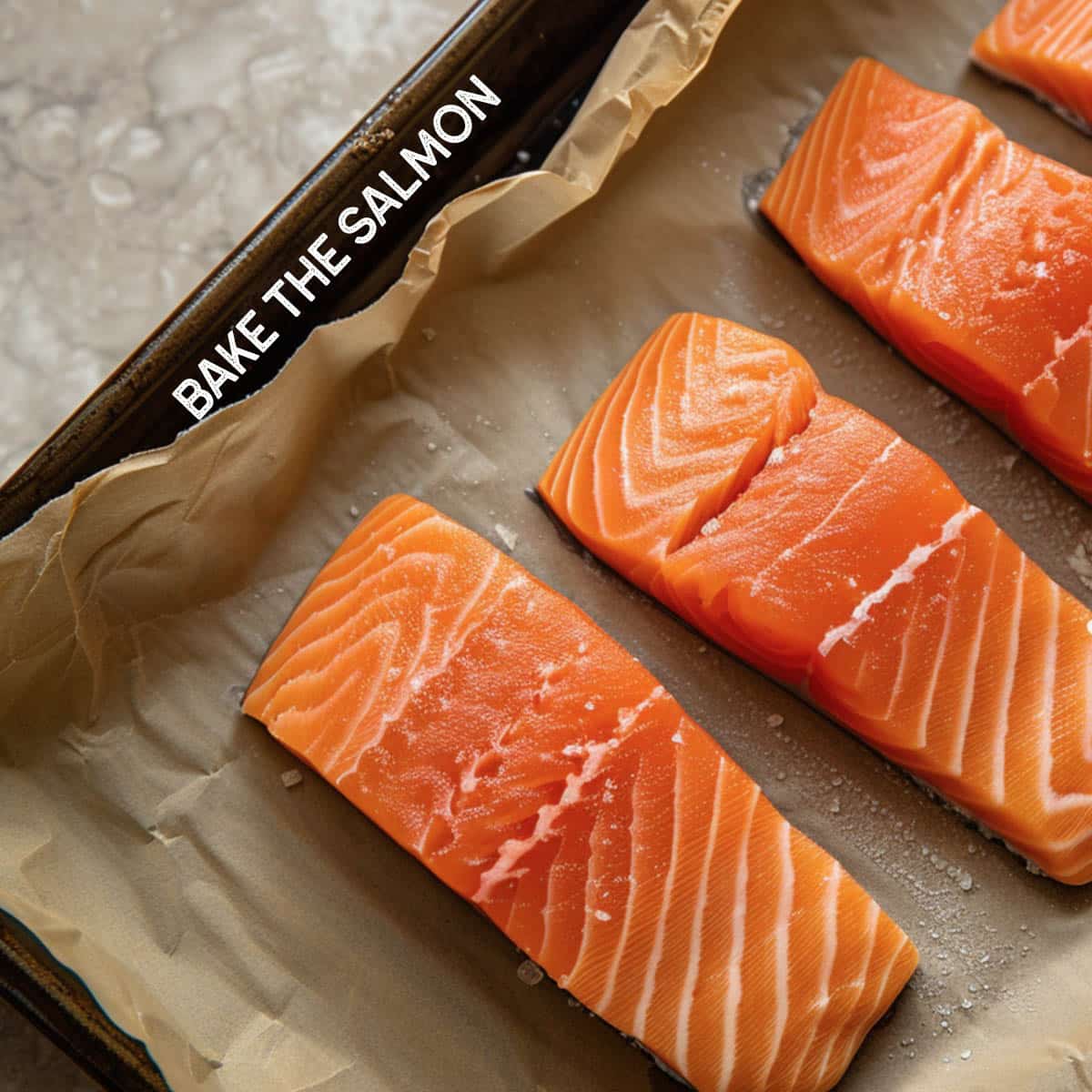
The Final Touches. Once your salmon is perfectly cooked, sprinkle a bit of sesame seeds or green onions over your fillets. Top it off with a drizzle of homemade teriyaki sauce. Serve it warm alongside steamed rice and your preferred vegetables.
Pro Tips:
- Sauce Prep Hack: Whip up your teriyaki sauce ahead of time. It's a lifesaver for those busy weeknights, turning dinner prep into a breeze.
- Sauce Leftovers Strategy: If you have some sauce left, no worries! It keeps well in the fridge for up to a week. Use it to jazz up lettuce wraps, chicken, beef, or shrimp.
- Oven Multi-Tasking Tip: Roasting a veggie at the same temp as your salmon? Genius move. It's a delicious, nutritious side that makes the most of your oven time.
- Next-Day Salmon Idea: Got some salmon left? Toss it in a salad for lunch the next day. It's just as yummy reheated or cold!
Related Recipes
- Cheesecake Factory Miso Salmon Copycat Recipe
- Furikake Salmon
- Guide to a perfect Furikake Salmon Air Fryer
- Furikake Salmon vs Teriyaki Salmon
- What to Serve with Furikake Salmon
Serving Suggestions for Teriyaki Salmon
1 Over Steamed Rice
Enjoy your teriyaki salmon over a bed of fluffy steamed rice. The savory flavors of the salmon pair perfectly with the simplicity of white or brown rice. The combination creates a satisfying meal that balances the sweetness of the teriyaki glaze.
For a complete meal, consider adding roasted asparagus or steamed broccoli on the side. These vegetables not only enhance the nutritional value but also add different textures to your dish. The vibrant colors will make your plate visually appealing too.
2 Garnished with Sesame Seeds and Green Onions
To elevate the visual appeal and flavor profile of your dish, don't forget to garnish your teriyaki salmon with sesame seeds and sliced green onions. The nuttiness of sesame seeds adds a delightful crunch, while green onions provide a fresh kick to each bite.
For an extra burst of freshness, serve alongside a refreshing cucumber salad or some pickled ginger. These sides offer contrasting tastes that complement the rich umami flavor of the teriyaki-glazed salmon perfectly.
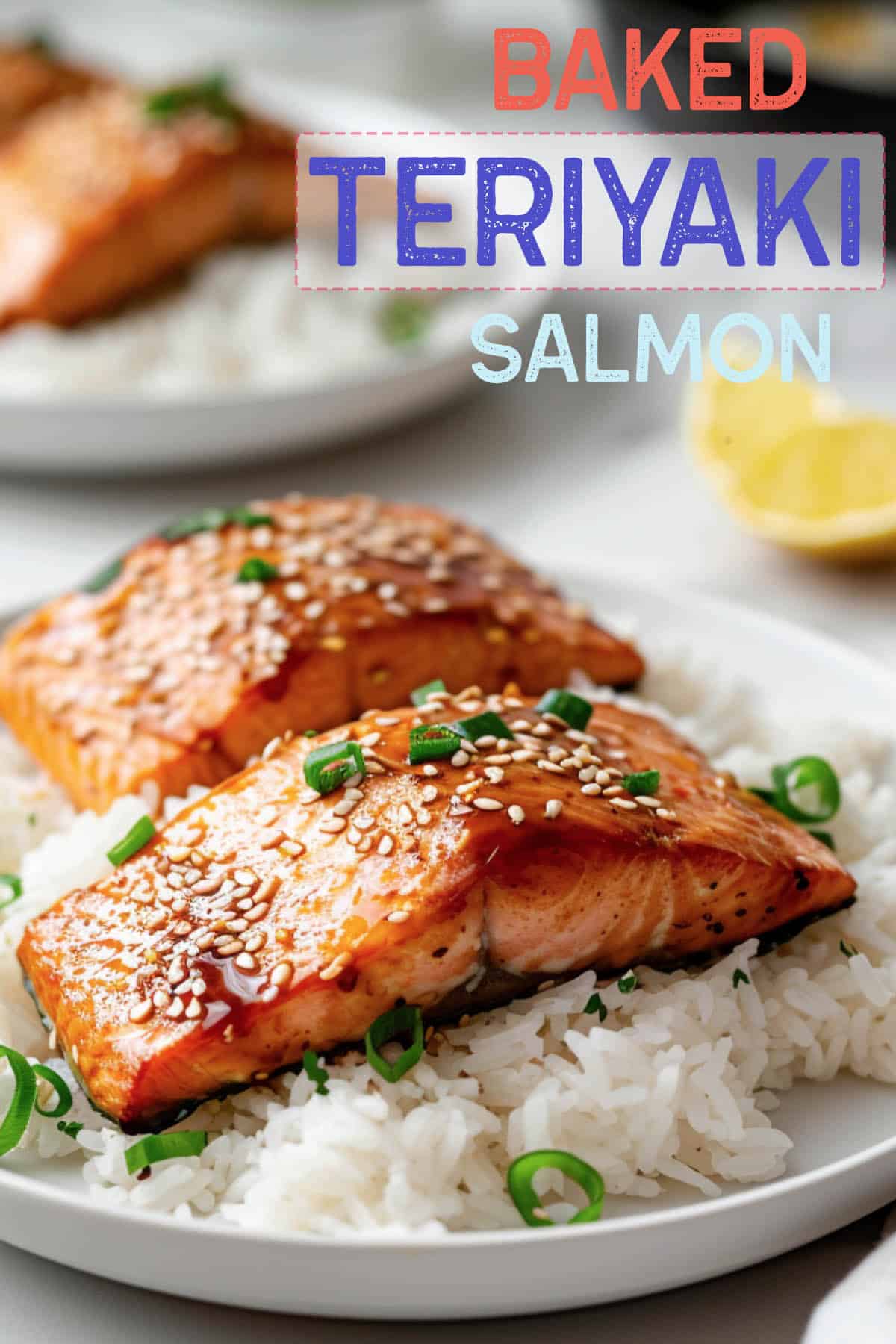
Tips for Making Authentic Teriyaki Salmon
1 Fresh Ingredients
Using fresh, high-quality ingredients is crucial when preparing teriyaki salmon. Fresh salmon will have a better texture and flavor compared to frozen fish. Opt for fresh ginger, garlic, and soy sauce to enhance the taste of your teriyaki sauce.
To make an authentic teriyaki glaze, combine soy sauce, mirin, sake (or white wine), sugar or honey, garlic, and ginger in a pan. Adjust the sweetness and saltiness of the sauce by tasting it as you cook. You can add more sugar or soy sauce based on your preference.
2 Cooking Technique
When cooking teriyaki salmon, avoid overcooking it to maintain its tenderness and moisture. Overcooked salmon becomes dry and loses its delicate texture. Cook the salmon until it turns opaque but still slightly pink in the center for optimal results.
Remember not to overcrowd the pan when searing or baking the salmon; this ensures even cooking throughout each piece of fish. Basting the salmon with extra teriyaki sauce while cooking can also help keep it moist and infuse more flavor into every bite.
Cutting Salmon into Japanese-Style Fillets
1 Removing Pin Bones
To prepare teriyaki salmon, start by checking for and removing any pin bones from the salmon fillet using tweezers or pliers. This step ensures a pleasant dining experience without encountering any unexpected hard bones while enjoying your meal.
It's crucial to take your time during this process, as it contributes to the overall enjoyment of your dish. By carefully eliminating these small bones, you can savor every bite of the tender and flavorful salmon fillets without any interruptions.
2 Slicing into Rectangular Pieces
After addressing the pin bones, proceed by cutting the salmon into rectangular pieces resembling traditional Japanese-style fillets. Aim for slices that are about 1 inch wide and 3 inches long to achieve an authentic presentation for your teriyaki salmon dish.
By slicing the salmon filets in this manner, you ensure that each piece cooks evenly and absorbs all the delicious flavors of the teriyaki marinade. Consistent sizing also helps with uniform cooking times, guaranteeing that each bite is cooked to perfection.
3 Ensuring Even Thickness
When slicing your salmon filets, pay attention to ensuring each piece has an even thickness throughout. This practice is essential for achieving consistent cooking results when preparing your teriyaki salmon.
Evenly sliced pieces cook uniformly, preventing some parts from being undercooked while others are overdone. By maintaining uniform thickness in each slice of salmon, you create a harmonious blend of textures and flavors in every mouthful.
Storing Teriyaki Salmon Properly
Refrigerator Storage
After enjoying your delicious teriyaki salmon, it's essential to store any leftovers properly. Transfer the remaining salmon into an airtight container and place it in the refrigerator. Remember, cooked teriyaki salmon can be safely stored in the fridge for up to 3 days.
When reheating your leftover teriyaki salmon, opt for gentle methods like using the microwave or oven. This approach helps maintain the fish's texture and flavor, ensuring a delightful eating experience even after storing it.
Freezing Caution
While refrigerating cooked teriyaki salmon is safe and convenient, freezing is not recommended. Freezing can impact the quality of the fish, altering its taste and texture negatively. Therefore, it's best to avoid freezing previously cooked teriyaki salmon.
- Pros:
- Maintains freshness for up to 3 days.
- Retains flavor when gently reheated.
- Cons:
- Freezing may alter taste and texture.
Nutritional Information of Teriyaki Salmon
Health Benefits
Salmon, a key ingredient in teriyaki salmon, is packed with omega-3 fatty acids that are great for heart health. It also offers a good dose of protein and essential vitamins.
- Sprague M, Dick JR, Tocher DR. Impact of sustainable feeds on omega-3 long-chain fatty acid levels in farmed Atlantic salmon, 2006–2015. Sci Rep. 2016;6:21892. Published 2016 Feb 22. doi:10.1038/srep21892
- Link to article
The teriyaki sauce, although flavorful, can increase the dish's sodium and sugar levels. By making adjustments to the ingredients used in the recipe, you can cater to different dietary requirements.
Consuming omega-3 fatty acids found in salmon helps lower inflammation in the body, reducing the risk of chronic diseases like heart conditions.
Protein from salmon aids in muscle growth and repair while supporting overall bodily functions. Vitamins present in this fish contribute to maintaining healthy skin, eyesight, and immune system function.
Dietary Adjustments
If you're watching your salt intake or sticking to a low-salt diet, don't worry, you can still enjoy teriyaki sauce. Opt for a reduced-sodium version or use it sparingly. This way, you can manage your salt consumption without missing out on flavor.
And for those cutting down on sugar, here's a tip: swap out regular sugar for natural sweeteners like honey or maple syrup when making your teriyaki sauce. It's a great way to reduce sugar while keeping that sweet taste you love.
Pros:
- Rich source of omega-3 fatty acids
- High protein content supports muscle growth
- Essential vitamins promote overall health
Cons:
- Teriyaki sauce may contain high levels of sodium
- Sugar content in the dish could be excessive if not controlled properly
Adjusting your teriyaki salmon recipe by incorporating more vegetables like broccoli or bell peppers not only enhances nutritional value but also adds fiber and additional nutrients to your meal. Substituting white rice with brown rice or quinoa boosts fiber intake while providing sustained energy release throughout the day.
Frequently Asked Questions
Full Recipe
Baked Teriyaki Salmon Recipe
Pin RecipeEquipments:
- baking dish or baking sheet
Ingredients:
- 4 pcs salmon filets
- ¾ cup Teriyaki sauce (divided) click the link for the recipe
Instructions:
Prep the Salmon
- To start making teriyaki salmon, begin by patting dry the salmon fillets with paper towels. This step helps remove excess moisture from the fish, ensuring a better texture when cooked. Once dried, place the salmon in a shallow dish or resealable plastic bag, ready to absorb all the flavors of the teriyaki sauce.
- Next, pour teriyaki sauce over the salmon fillets in the dish. The rich and savory teriyaki sauce will add depth and sweetness to your salmon dish. Ensure that each piece is generously coated with the sauce for maximum flavor infusion.
- After pouring the teriyaki sauce, allow your salmon to marinate for at least 30 minutes in the refrigerator. During this time, cover your dish with plastic wrap or aluminum foil to prevent other odors from seeping into your marinade. The longer you let it sit (up to overnight),the more intense and flavorful your teriyaki salmon will be when cooked.
Baking instructions for teriyaki salmon
- First things first, crank your oven up to 400°F (200°C). This step ensures that the oven reaches the right temperature for cooking.Why preheat? Well, it's like giving your oven a heads-up, "Hey, we're cooking something great here!" It ensures your salmon cooks evenly, no undercooking or overcooking mishaps. It's all about setting the stage for your salmon to shine.
- Setting Up the Baking Sheet. Now, let's get your baking sheet ready. You lay down parchment paper or foil first – keeps everything clean and makes tidying up a breeze later on.
- Bake the Salmon. Okay, let's break down the cooking time for salmon, because it's not a one-size-fits-all kind of deal. The thickness of your salmon? It matters. And the type – like, if it's a fattier piece, you've got a bit more leeway before it goes from juicy to dry.Here's what I suggest: Give it a check around the 10-12 minute mark. You're aiming for a light pink color throughout. No dark pink or red bits that scream 'I'm not cooked yet!' The perfect piece should flake off easily and be tender, not tough.
- The Final Touches. Once your salmon is perfectly cooked, sprinkle a bit of sesame seeds or green onions over your fillets. Top it off with a drizzle of homemade teriyaki sauce. Serve it warm alongside steamed rice and your preferred vegetables.
Notes:
Pro Tips:
- Sauce Prep Hack: Whip up your teriyaki sauce ahead of time. It's a lifesaver for those busy weeknights, turning dinner prep into a breeze.
- Sauce Leftovers Strategy: If you have some sauce left, no worries! It keeps well in the fridge for up to a week. Use it to jazz up lettuce wraps, chicken, beef, or shrimp.
- Oven Multi-Tasking Tip: Roasting a veggie at the same temp as your salmon? Genius move. It's a delicious, nutritious side that makes the most of your oven time.
- Next-Day Salmon Idea: Got some salmon left? Toss it in a salad for lunch the next day. It's just as yummy reheated or cold!
Nutrition Information:
Please note that all nutrition information are just estimates. Values will vary among brands, so we encourage you to calculate these on your own for most accurate results.

